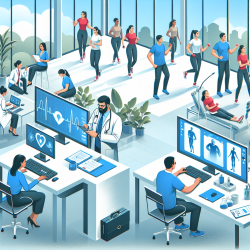Introduction
In the dynamic landscape of corporate wellness, practitioners play a crucial role in fostering a healthier workforce. The study titled "Health of the Corporate Worker: Health Risk Assessment Among Staff of a Corporate Organization in Ghana" provides valuable insights into health risk assessments (HRA) that can be leveraged to enhance workplace health initiatives. By understanding and implementing the outcomes of this research, practitioners can significantly improve their skills and contribute to the well-being of employees.
Understanding Health Risk Assessments
Health risk assessments are systematic approaches to collecting data on individuals' health risks, providing feedback, and linking them to interventions. These assessments typically gather information on demographics, lifestyle choices, medical history, and physiological data such as BMI and cholesterol levels. The research conducted in Ghana highlights the importance of HRAs in identifying health risks among corporate workers, particularly in low-income settings.
Key Findings from the Research
The study involved a cross-sectional analysis of staff in a large media organization in Ghana. Key findings include:
- A significant portion of the workforce was unaware of their health risks, with higher risks observed among senior staff and management.
- Prevalence of obesity was 63.8%, and 49.1% of staff had above-normal cholesterol levels.
- Hypertension was self-reported by 31.7% of workers, while measured blood pressure indicated a 60.2% prevalence of diastolic hypertension.
These findings underscore the need for regular health education and promotion activities in the workplace.
Implementing HRAs in Practice
Practitioners can utilize the insights from this research to implement effective HRAs in their organizations. Here are some steps to consider:
- Conduct Regular Assessments: Schedule periodic HRAs to identify and monitor health risks among employees. This proactive approach can help in early detection and intervention.
- Promote Health Education: Organize educational sessions to raise awareness about common health risks and preventive measures. Tailor these sessions to address specific needs of different staff categories.
- Foster a Supportive Environment: Encourage a workplace culture that prioritizes health and well-being. Implement policies that support healthy lifestyles, such as flexible work hours for physical activity.
- Collaborate with Health Professionals: Work with occupational health practitioners to design and implement comprehensive health promotion programs.
Encouraging Further Research
The findings from the Ghana study highlight the potential for further research in different settings and industries. Practitioners are encouraged to explore similar assessments in their contexts to gather data that can inform tailored interventions. By sharing insights and outcomes, practitioners can contribute to a broader understanding of workplace health dynamics.
Conclusion
Health risk assessments are invaluable tools for practitioners aiming to improve workplace health. By implementing the outcomes of the Ghana study, practitioners can enhance their skills and contribute to a healthier, more productive workforce. Regular HRAs, combined with health education and supportive environments, can lead to significant improvements in employee well-being.
To read the original research paper, please follow this link: Health of the corporate worker: health risk assessment among staff of a corporate organization in Ghana.










